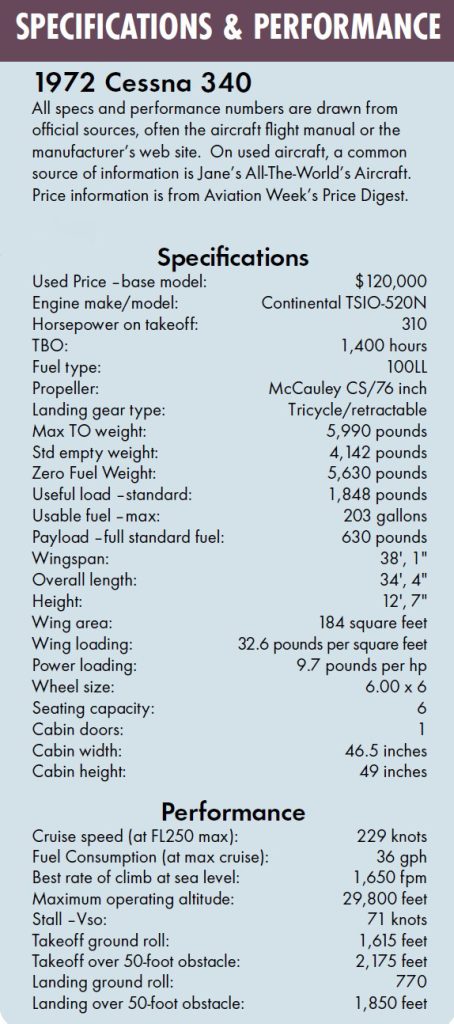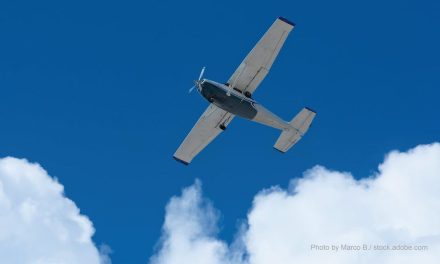Cessna’s entry-level inflatable twin
You’d never know it by looking at the list of today’s production aircraft, but pressurized piston twins used to be all the rage. At one time in the late ’70s, the modern heyday of general aviation, Cessna was building four inflatable piston twins; Beech and Aero Commander had two apiece; and Piper and Aerostar offered one each.
If that sounds like too much of a good thing, it turned out to be exactly that. By the mid-1980s, sale of pressurized twins had diminished to a precious few, and all 10 models went out of production, perhaps partially because of the difference between single and twin prices. In 1980, a typical out-the-door tab for a 340 was $330,000 while an average-equipped 1980 P210 cost $115,000.
As the example above suggests, twins — especially complex, turbocharged, and pressurized twins — cost far more than twice the tab for singles and operating expenses help multiply the cost. Together, both factors helped dry up the market for complex twins by 1986. As one twin owner commented sardonically when I asked him about the cost of maintenance, “Yeah, operating costs on twins do increase by a factor of two — they square.”
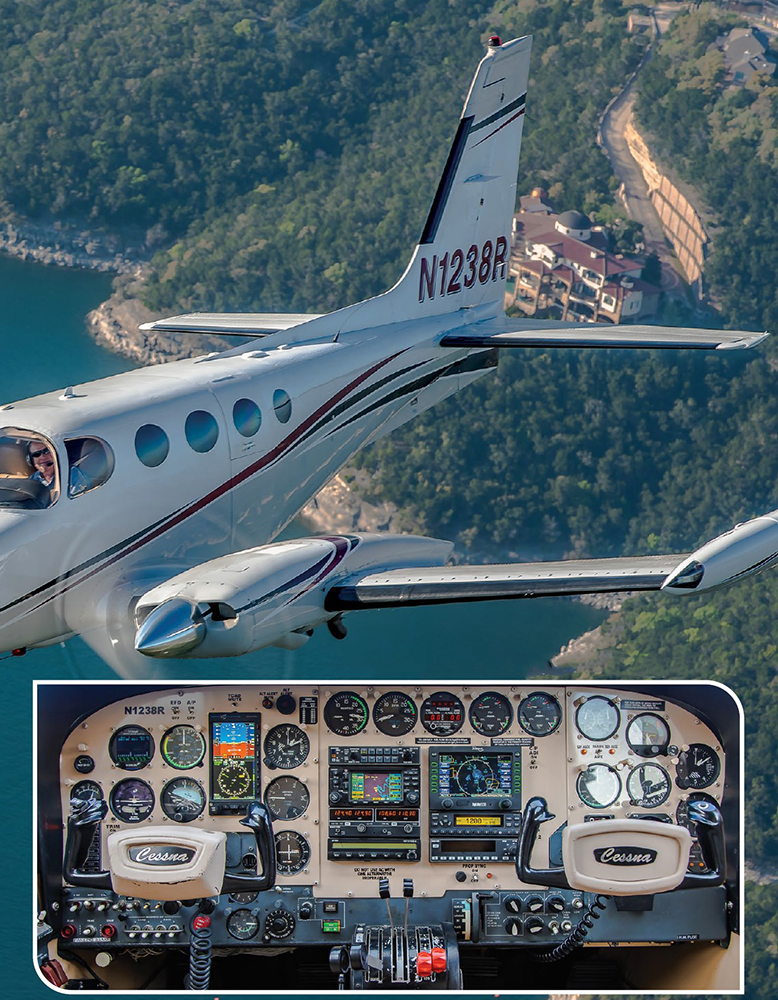
With so many airplanes to choose from during the twin boom, buyers purchased a large gaggle of the type, and so today we’re left with an interesting selection of used, complex multis many with low total time and upgraded avionics.
The usual question is which used, pressurized twin makes the most sense for a pilot looking to transition to the imaginary safety of two engines? In the real world, the safety of a redundant engine is often more than offset by the difficulty of managing asymmetric power. Perhaps equally important, which of the pressurized twins is most adaptable to a pilot with minimum multi time who’s still working on his first million?
My vote usually goes to the Cessna 340. I’ve recommended 340s to a number of overseas clients and delivered a few of the type to places such as South Africa, the Philippines, and Australia. Several years ago, I helped a friend purchase a fairly pristine example out of West Palm Beach, Florida.
We had an extremely comprehensive prebuy inspection done by Bill Turley of Aircraft Engineering Inc. in Bartow, Florida. When the candidate aircraft came back relatively clean, the new owner and I jetted down, handed over the check, picked up the Cessna, and flew it home to Long Beach, California. Last I heard, he still owns it and he’s still my friend, so it must have been a good choice.
The reason 340s are preeminent as a best buy is that they offer more than enough for less than too much. They’re not the fastest or the most economical bimotored machines, but Cessna did a competent job on the original design. The type has proven resilient against the hands of time and there are plenty of airplanes to choose from.
Cessna built 340s from 1972 to 1984, and the company produced some 1,200 340s in those 13 years. Apparently, no one at Cessna ever thought of a name to go with the model number.
337 experiment
The only less-expensive pressurized twin from anyone happens to be another Cessna: the pressurized 337 Skymaster. This was a push-pull design with engines mounted fore and aft on the fuselage rather than on the wings. It was the company’s entry-level twin, allegedly intended to improve twin-engine safety by eliminating asymmetric thrust. Unfortunately, it was such an oddball design that it never truly caught on.
The price of avoiding asymmetric thrust was that the rear engine ran hot and heat problems often resulted in premature top and major overhauls on the aft mill. Another problem was the model’s low pressurization differential of 3.37 psi. This was a result of trying to pressurize an existing fuselage that was essentially a box.
Pretty obviously, a tube is easier to seal than a semi-rectangular fuselage, and Cessna determined that 3.37 psi was the limit. That translated to a 10,000-foot cabin at 20,000 feet and many prospective buyers felt that didn’t allow the kind of altitude flexibility necessary for a business twin.
Pressurization is, after all, the ultimate luxury in piston airplanes, but it must offer the flexibility to operate over the weather to be effective. Pressurization bypasses one of the main objections some pilots have to travel in general aviation airplanes: It allows the aircraft to trick the sky into letting passengers continue to breathe sea level air at heights of 2 miles or more above the sea and forego oxygen masks at 4- to 5-mile heights.
This means you can plan a full day’s flying without worrying about the debilitating effects of oxygen deprivation from 7 or 8 hours at high altitude, an important consideration for middle-aged buyers who’ve financially arrived but whose hypoxia tolerance isn’t what it once was.
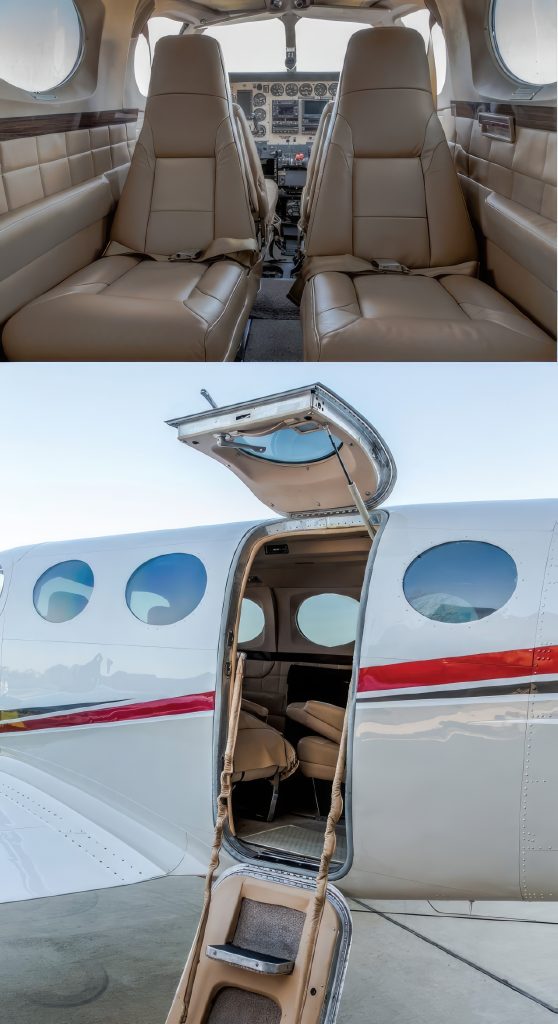
The 340 incorporated in a single airplane an air stair door leading to a wide, comfortable, cabin-class aft compartment with conference-style seating, along with turbocharging and pressurization with a maximum 4.25 psi differential. This allows a cabin altitude of 10,000 feet at an aircraft altitude of 25,000 feet.
Unpressurized option
The cost of pressurization is rarely well defined, but Cessna offered a perfect comparison in 1980. That was the year the company expanded its product line to include the 335 — a 340 without all the pressurization pumps, tubing, valves, and cabin beef-up.
In other words, the 335 was a 340 sans pressure. In that year, Cessna listed an average-equipped price of $330,355 for the 340 and $271,275 for the 335. The delta for the privilege of pressurization was $59,080. If you were willing to wear an oxygen mask, the 335 offered exactly the same performance. Along with the lower sticker price, the 335 benefitted from a significant weight reduction.
Both airplanes enjoyed a max gross weight of 5,990 pounds; however, eliminating the 340’s pressurization hardware and accompanying structural strengthening saved 179 pounds. This translated directly to payload since fuel capacity remained the same on both airplanes.
Unfortunately, Cessna sold only 65 of its 335s before deciding the whole thing was a bad idea. The company canceled the model after a single year of production. We’re left with an interesting head-to-head comparison between pressurized and unpressurized versions of the same airplane.
In 2007, Piper tried the same trick on the Mirage. It removed all pressurization hardware from the Malibu Mirage and created the Matrix. The result, not too surprisingly, was 150 pounds saved and transferred directly to payload. It’s fairly apparent the weight penalty of pressurization is between 150 and 200 pounds, equivalent to one extra passenger.
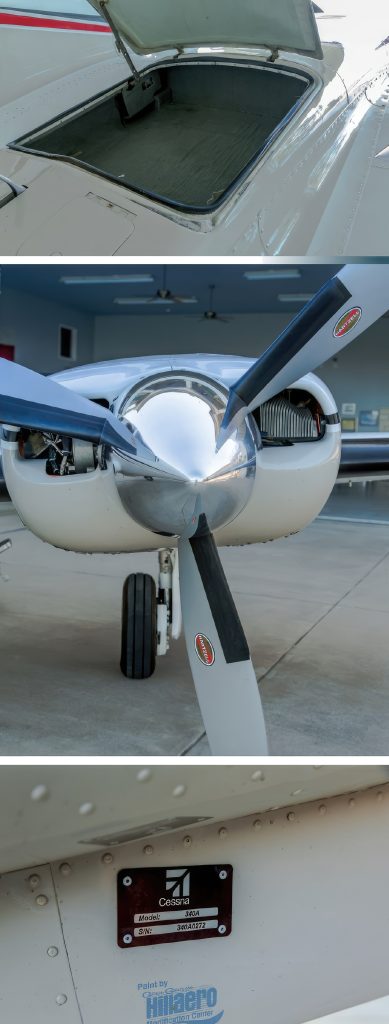
Powerplant
The original 340s were introduced with a pair of heavy breathing Continental TSIO-520K engines for power. These were rated for 285 hp to a critical altitude of 12,000 feet. The engines were later upgraded to 310 hp. In the aftermarket, pilots often opted for the higher power when the engines reached their 1,400-hour TBO.
A popular conversion for even more power was the RAM VII mod that boosted power to 335 hp per side. RAM Aircraft in Waco, Texas, has long specialized in mods to increase power and operating efficiency on turbocharged Cessna twins and other models.
Like many six-seat aircraft, the stock Cessna 340 is better suited to four occupants than full seats. It’s not a true six-place machine in standard configuration. The RAM conversion installs vortex generators and allows a gross weight increase of 300 pounds, boosting top weight to 6,290 pounds. That pumps up the full fuel payload to 1,160 pounds — six folks plus a respectable 140 pounds of baggage.
For that reason, many owners of 340s not fitted with the RAM power and VG upgrade remove one seat to eliminate the temptation of carrying a pilot and five passengers. The cabin is a comfortable 46.5 inches wide, 4 inches broader than a Baron’s, enough for three rows of two seats each with an aisle down the center. The airplane also can be fitted with a divider separating the front cockpit from the aft passenger compartment for corporate operation.
Cessna 340s recorded good performance for a 6,000-pound twin. Most could climb at 1,500 fpm without straining and maintain strong ascent to 15,000 feet or more. The airplane was rated for flight as high as 25,000 feet, though most pilots favored operation in the high teens (service ceiling was actually near 30,000 feet, but the pressurization system couldn’t handle such high altitude).
Level at 17,500 feet, a typical 340 could truck along at nearly 200 knots. The spec for FL250 was allegedly 229 knots TAS. A more realistic number was 215 knots, still a reasonable cruise speed.
Landing characteristics are predictably gentle. Stalls are as honest as a Kansas sunrise, so benign that it’s hard to imagine anyone getting into trouble in a 340. The airplane is as tractable going into semi-short mini airports of 2,000 feet or more as it is landing at the JFKs and LAXs of the world. VMC isn’t much above stall, even lower with the RAM VG system installed. The 340’s gear is taken straight from the Cessna 414 Chancellor, an airplane that grosses 6,750 pounds, so it’s probably tough enough to withstand dirt strips.
Today, the early 340s represent an impressive buy for the pilot looking for twin engine redundancy at a reasonable price. The earliest examples, 1972-1974 models, sell for about $120,000 and the last production 340s, 1982-1984 vintage, bring about double that.
It’s important to remember, however, that a complex twin is far more expensive to maintain and operate than even a top-line single. Fuel burn is the least of your concerns, and even that is 36-38 gph at max cruise. Maintenance is a major economic concern, since the newest 340 is now more than 30 years old. Exhaust systems, turbochargers, cylinders, and myriad other components can drive the cost of annual into five figures on a regular basis.
Still, if you embrace 340 ownership with an open mind to the costs involved, the type can be an interesting alternative to new singles that may be priced at four- to five-times the 340’s used tab.
Just remember, as with operating most other twins, bring money.

Glenn Chiappe flies N1238R for LTX Consulting in Austin, Texas, and flew the 340 for the photos in this issue. We asked him what he thinks of the twin.
Typical trips are in the 1- to 3-hour range and the 340 gives good service in the “teens” for cruise altitude. This particular airplane has gyro-smooth RAM engines and typical cruise for me is 30-32 inches of manifold pressure, 2300 rpm at 190-195 knots TAS, and we see about 17 gph per side ROP. The fuel system is complex with six fuel tanks, but once you understand it, it’s quite easy to deal with. This airplane has two nacelle fuel tanks that bring our fuel capabilities to 203 gallons total.
The upgraded S-TEC 55X autopilot and Aspen PFD make IFR ops in this airplane very comfortable. This airplane also has the Keith “electric” air-conditioning, which is highly desirable (in my opinion) to the factory system that was hydraulically driven (the other 340 that I fly does not have as good an environmental system). The Keith system is much better at keeping the passengers cool on those hot Texas summer days. At altitude, we can almost always keep the cabin comfortable using the pressurization air, and not needing to fire up the gas-burning heater. That is usually only needed in extremely low temps and it works very well. This particular airplane is not certified for flight into known icing, but the boots and alcohol systems are nice to have should we descend into something unexpected.
The 340 is a straight-forward airplane to fly. Useful load is just over 1,700 pounds. CG likes to have us fill the nose baggage compartment if we have passengers in the back seats. The airplane will fly off the runway at very low airspeeds, but we like to hold it on the runway to Vmc plus 10 or more should we have an issue with an engine. Approaches are flown at 110 knots and we can hold blue-line (or better) all the way down final with full-flaps, gear down, and carrying some power during the final. The two big Hartzell Scimitar propellers will slow the airplane quickly when the throttles are brought to idle in the flare. Touchdown is a non-event.
Overall, the Cessna 340 is a very capable airplane. The pressurization system makes passenger comfort excellent, and the cabin size is good for a personal twin-engine aircraft.
